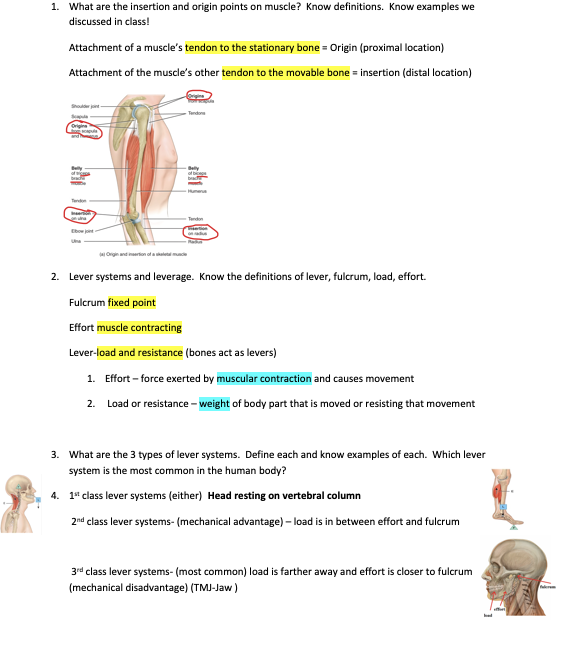chapter 11
What are the insertion and origin points on muscle? Know definitions. Know examples we discussed in class!
Attachment of a muscle’s tendon to the stationary bone = Origin (proximal location)
Attachment of the muscle’s other tendon to the movable bone = insertion (distal location)
Lever systems and leverage. Know the definitions of lever, fulcrum, load, effort.
Fulcrum fixed point
Effort muscle contracting
Lever-load and resistance (bones act as levers)
Effort – force exerted by muscular contraction and causes movement
Load or resistance – weight of body part that is moved or resisting that movement
What are the 3 types of lever systems. Define each and know examples of each. Which lever system is the most common in the human body?
1st class lever systems (either) Head resting on vertebral column
2nd class lever systems- (mechanical advantage) – load is in between effort and fulcrum
3rd class lever systems- (most common) load is farther away and effort is closer to fulcrum (mechanical disadvantage) (TMJ-Jaw )
5. What is mechanical advantage?
If load is closer to fulcrum and effort is farther from fulcrum, then only a small effort is needed to move a large load over a small distance (mechanical advantage)
How does load and effort play a role?
The load is what you want to lift , and effort is the force you exert to lift it
What is the relationship between force and speed?
Muscles cannot provide great force AND greater range of motion – it’s one or the other (mechanical tradeoff
Advantage and disadvantage distance between the fulcrum and load and the point at which an effort is applied
Arrangement of fascicles (parallel, fusiform, circular, triangular, pennate: unipennate, bipennate, multipennate). Know definitions . Which ones provide more power? More range of motion?
a. Pennate- greater power – smaller range of motion
b. Parallel – greater range of. Motion but less power
Definitions for the following: prime mover/agonist, antagonist, synergist, fixator, compartment. What are examples of each?
Prime mover/agonist – leader, contracts to cause an action
antagonist– other muscle stretches and yields to the effects of the prime mover (against prime mover)
ex: flexing forearm at elbow: biceps prime mover (contracts) triceps are antagonist (stretch)
c. synergist – most movements also involve muscles
i. Sometimes prime mover crosses other joints before it reaches joint at which primary action occurs
ii. Biceps brachii spans both shoulder and elbow joints (primary action on forearm)
iii. Synergists – prevent unwanted movements at intermediate joints and aid in movement of prime mover
iv. Located close to prime mover
v. Ex of synergist Muscles that flex the fingers (prime mover) cross the intercarpal and radiocarpal joints (intermediate joints; joint between radius and carpals) you would not be able to flex your fingers without flexing your wrist at same time
d. Fixators – synergist muscles - Some synergist muscles in a group act as fixators
i. stabilize the origin of the prime mover so that it can act more efficiently
ii. steady proximal end of limb while movement occurs at distal end
iii. EX:
iv. Scapula is freely movable bone that serves as origin for several muscles that move arm
v. When arm muscles contract, the scapula must be held steady
e. Compartment- A comparmentis a group of skeletal muscles, their associated blood vessels, and associated nerves
i. All of which have a common function
ii. In upper forelimbs, flexor compartment muscles are anterior
iii. Extensor compartment muscles are posterior (top of forearm)
How are skelet al muscles named? (hint: there are 7 ways in your lecture notes) Be able to identify position of muscles based on the names. Suffixes? What do they mean? Table 11.2! For example, what does “rectus” mean? Orbicularis? Glossus?
Direction, size, shape, action, number of origin,, location, origin and insertion
· Orbicularis – means that the fascicles are arranged in a circle
Oculi – refers to eye
Oris – refers to lips
· Rectus – parallel to midline
· -Glossus- tongue
What does intrinsic and extrinsic mean? What are the extrinsic eye muscles?
Extrinsic s originates outside of where it inserts
Intrinsic originates and inserts in the same location
Extrinsic muscles
Originate outside tongue and insert into it
Move entire tongue in various directions
All names end in “glossus” (“glossus” means tongue)
Named by origin and insertion (ex. Palatoglossus; raises back of tongue)
Intrinsic muscles
Originate and insert within tongue
Alter shape of the tongue rather than move the entire tongue
Extrinsic eye muscles- muscles outside eye
Which abdominal muscle is the most important muscle that powers breathing?
diaphragm
Muscles that act on the digits are divided into extrinsic and intrinsic muscles. Where do extrinsic muscles originate and insert? What about intrinsic?
Extrinsic muscles – located in the anterior and posterior compartments of the forearm. They control crude movements and produce a forceful grip. Intrinsic muscles – located within the hand itself. They are responsible for the fine motor functions of the hand
